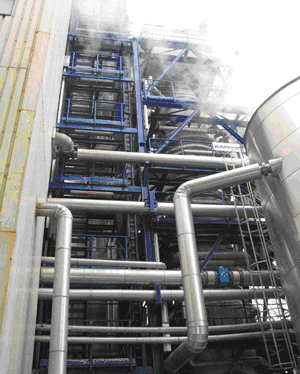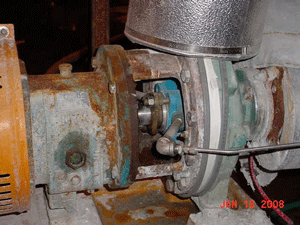The chemical and pulp and paper industries are two of the largest industrial consumers of water, so pressure is mounting on both to use water more efficiently in light of increasing scarcity across many parts of the world.
The Industrial Technologies Program of the U.S. Department of Energy (DOE) seeks to achieve a 30 percent reduction in the U.S. chemical industry's energy and water consumption per unit of output by 2020. A similar initiative is being undertaken in the pulp and paper industry under the auspices of the DOE, research institutes and leading paper companies.
Losses from leaking pumps significantly contribute to the water consumption of these industries, but a rotary shaft sealing system is helping both dramatically reduce water use. Designed to replace mechanical seals in many pump applications, the new sealing system consists of flexible graphite with flow control rings inside the set. It is basically a hybrid between traditional braided type packing and a mechanical seal.
One of the system's primary benefits is the low leakage of the compression packings. Prior to its development, pump flushing systems wasted millions of gallons of water keeping seals clean. Unlike mechanical seals and compression packing, the new system does not use water to lubricate seal surfaces. Instead, it hydraulically loads the seal and acts as a barrier fluid, preventing process media from migrating into the stuffing box. It can be installed in about one hour, compared with the four to six hours needed to install mechanical seals.
The new seals can withstand adverse pump conditions, outperforming both mechanical seals and conventional compression packing in flushed abrasive services. They perform reliably at the reduced power consumption of a balanced mechanical seal and use 60 times less flush water than a comparable compression packing.
Case Studies
A chemical plant in Ohio realized substantial savings by converting to these rotary seals for the ANSI pumps in its brine system. It had been using $1,500 titanium double mechanical seals, which the corrosive brine was destroying within six weeks of installation.
The rotary seals provided two to three times longer service life than the mechanical seals, saving the plant nearly $100,000 a year, plus more than $12,000 in reduced installation costs. Additionally, they increased safety and production uptime.
In another application, these seals saved a Georgia paper mill nearly $17,000 a year per pump. The mill had been using both compression packing and mechanical seals in its digester pumps (see Figure 1), but the abrasive content and caustic nature of the raw white liquor resulted in chronic leakage.

Figure 1. Elastomer bellows seals in this sodium silicate pump were replaced with a sealing system that reduced its water consumption tenfold.
The vast amounts of flush water had to be removed from the media mechanically or by means of evaporation. At a flush rate of 40 gpm, the mill was using 9.5 million gallons a year at $200 per million gallons, plus an additional $1,800 per million gallons to remove and treat the flush water. The mill spent more than $20,000 a year on just one pump. By converting to rotary seals, it reduced water consumption by 75 percent and extended the mean time between maintenance threefold.
A major chemical producer had been using elastomer bellows cartridge seals in its sodium silicate pumps (see Figure 2). Sodium silicate is an abrasive viscous liquid that hardens when exposed to the atmosphere. As a result, it formed deposits on the seal faces, requiring them to be replaced frequently, a costly proposition at $1,100 per seal, plus a $100 sleeve and $500 in labor. In addition, flush water usage was one gallon per minute at $2.30 per thousand gallons, or $1,192 per year. The pumps operated at 100 deg F, 1,750 rpm and 45 psi.

Figure 2. Replacement of packing and mechanical seals in this pulp digester reduced water consumption by 75 percent and increased mean time between maintenance threefold.
The rotary seal manufacturer recommended replacing the seals with a leak-free, no-dilution sealing system. At less than half the cost of the replaced mechanical seals, the system reduced the pumps' water consumption from 60 gph to 10 gph, saving nearly 440,000 gallons or $1,000 a year per pump. For the 40 silicate pumps at the site, the annual savings was 17,520,000 gallons, or $40,000. In addition, labor only costs $100 when it comes time for replacement, compared with $500 for the cartridge seals.
Another application involved a paper producer concerned about the volume of flush water it was using in pump seal applications. Specifically, one of its mills was seeking a better sealing solution for its primary fan pump, which feeds stock to the head box of the paper machine. The stock is abrasive, so traditional rotary sealing methods required large volumes of flush water to keep the suspended material from contaminating sealing surfaces.
The pump had two stuffing boxes, each requiring a rotary seal. The mill had been sealing it with braided packing, which required a flush rate of 600 gph per stuffing box for a total of 1,200 gph. The seal manufacturer recommended replacing the braided packing with a rotary sealing system to reduce water consumption, eliminate process dilution and extend service life.
The system's split-component design allowed the maintenance staff to service the pump in place with assistance from the distributor, who oversaw the installation. To facilitate the process, the manufacturer provided installation instructions and a two-piece, interlocking installation tool customized to the mill's pump to seat the inboard sealing elements.
After a 12-hour run-in period, the mill was able to reduce the flush rate to 15 gph for each of the stuffing boxes, or 30 gph for the pump-a decrease of 97.5 percent. Flush water flow was measured with a rotary meter and controlled with a needle valve, both of which were supplied by the manufacturer and installed with the seals.
"The new system has the potential to extend equipment life, reduce energy consumption from leaking seal water, replace high-dollar mechanical seals and reduce equipment downtime because it is so easy to install," a mill spokesperson said. "We have installed the system in one of our most problematic areas, and it has performed flawlessly. We will definitely continue to install this system wherever there is an opportunity."
The reduction in flush requirements of this single pump translates into an annual savings of 10.2 million gallons. Since the initial installation on the primary fan pump, the maintenance staff has installed it on the secondary fan pump and is investigating other water-intensive mill areas.
Mechanical seals and conventional compression packing remain viable methods of sealing pumps in process applications. In hostile environments and abrasive operating conditions, hydraulically loaded seals have been field-proven to perform reliably and cost-effectively over longer maintenance cycles, dramatically reduce water consumption and eliminate the risk of catastrophic failure.
Pumps and Systems, April 2010


